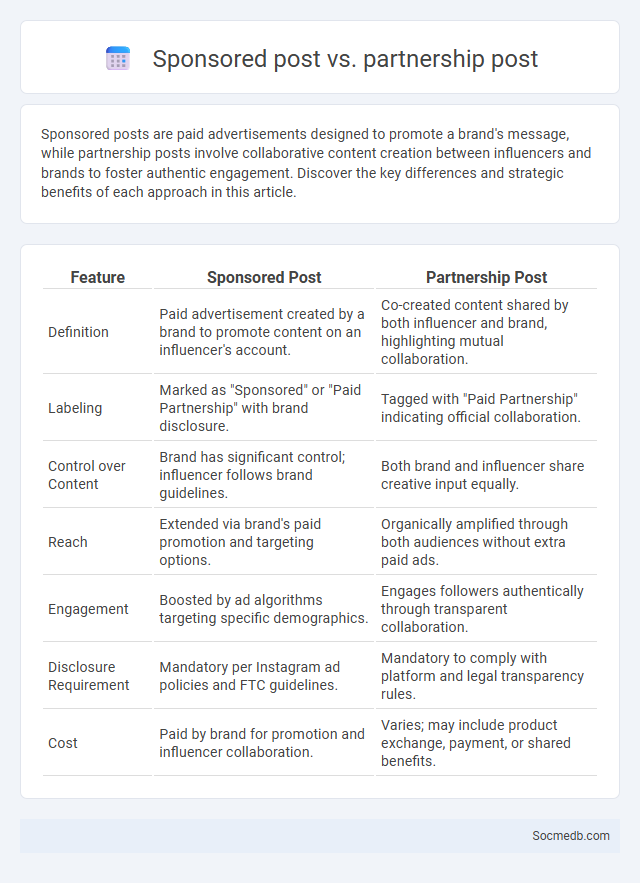
Photo illustration: Sponsored post vs partnership post
Sponsored posts are paid advertisements designed to promote a brand's message, while partnership posts involve collaborative content creation between influencers and brands to foster authentic engagement. Discover the key differences and strategic benefits of each approach in this article.
Table of Comparison
| Feature | Sponsored Post | Partnership Post |
|---|---|---|
| Definition | Paid advertisement created by a brand to promote content on an influencer's account. | Co-created content shared by both influencer and brand, highlighting mutual collaboration. |
| Labeling | Marked as "Sponsored" or "Paid Partnership" with brand disclosure. | Tagged with "Paid Partnership" indicating official collaboration. |
| Control over Content | Brand has significant control; influencer follows brand guidelines. | Both brand and influencer share creative input equally. |
| Reach | Extended via brand's paid promotion and targeting options. | Organically amplified through both audiences without extra paid ads. |
| Engagement | Boosted by ad algorithms targeting specific demographics. | Engages followers authentically through transparent collaboration. |
| Disclosure Requirement | Mandatory per Instagram ad policies and FTC guidelines. | Mandatory to comply with platform and legal transparency rules. |
| Cost | Paid by brand for promotion and influencer collaboration. | Varies; may include product exchange, payment, or shared benefits. |
Understanding Sponsored Posts
Sponsored posts on social media are paid advertisements designed to blend seamlessly with your regular content, increasing brand visibility and engagement. These posts use targeted algorithms to reach specific audiences based on your demographics, interests, and online behavior. Your awareness of sponsored content ensures informed interactions, helping you distinguish genuine recommendations from promotional material.
What Defines a Partnership Post?
A partnership post on social media is defined by a clear collaboration between a brand and an individual or influencer, where both parties contribute to the content and share mutual benefits. These posts often include explicit disclosures like #ad or #sponsored to maintain transparency and comply with advertising regulations. The partnership is characterized by shared goals such as brand awareness, audience engagement, and authentic promotion through trusted voices.
Exploring Brand Partnerships
Exploring brand partnerships on social media enhances reach and engagement by leveraging influencers and complementary brands with aligned target audiences. Strategic collaboration maximizes user-generated content, authentic storytelling, and cross-promotion across platforms such as Instagram, TikTok, and LinkedIn. Data-driven insights on audience demographics and content performance optimize partnership selection and campaign effectiveness.
Key Differences: Sponsored vs Partnership vs Brand Partnership
Sponsored content involves a brand paying an individual or platform to promote products or services, typically with clear disclosures and short-term goals. Partnerships often denote a collaborative relationship where both parties mutually benefit, sharing resources and influence to achieve aligned marketing objectives over a medium term. Brand partnerships represent deeper, strategic alliances aiming for long-term co-branding initiatives, integrated campaigns, and joint innovation to enhance brand equity and consumer engagement.
Benefits of Sponsored Posts
Sponsored posts on social media enhance brand visibility by targeting specific audiences with tailored content, resulting in improved engagement rates and higher conversion opportunities. These posts leverage platform algorithms to increase reach, allowing businesses to promote products or services efficiently while measuring campaign performance through analytics. Brands benefit from increased credibility and trust when sponsored content is seamlessly integrated into users' feeds, driving both awareness and sales growth.
Advantages of Partnership Posts
Partnership posts on social media amplify your brand's reach by combining audiences and leveraging mutual credibility, resulting in higher engagement rates and enhanced trust. These collaborations allow for creative content that resonates with diverse demographics, increasing the likelihood of viral sharing and follower growth. Your strategic use of partnership posts can lead to improved brand awareness and measurable ROI through shared analytics and targeted campaigns.
Why Choose Brand Partnerships?
Brand partnerships amplify your social media reach by leveraging the established audiences of complementary businesses, driving higher engagement and authentic connections. Collaborating with trusted brands enhances your credibility and boosts customer trust through shared values and experiences. Choosing brand partnerships strategically accelerates your growth by combining resources, creative efforts, and marketing channels for amplified impact.
Disclosure and Transparency Requirements
Social media platforms enforce strict disclosure and transparency requirements to ensure users like You understand the origins and intentions behind promoted content. These regulations mandate clear labeling of sponsored posts, advertisements, and influencer partnerships to foster trust and authenticity. Compliance with these standards protects Your online experience from misleading or deceptive information.
Impact on Audience Engagement
Social media platforms significantly enhance audience engagement by enabling real-time interactions and personalized content delivery, which increases user retention and participation. Algorithms tailor your feed to showcase relevant posts, encouraging more meaningful connections and active involvement. Effective use of multimedia content like videos and stories further captivates your audience, driving higher engagement rates.
Choosing the Right Collaboration Model
Selecting the appropriate social media collaboration model hinges on aligning brand goals with audience engagement strategies, such as influencer partnerships, co-creation campaigns, or community-driven content initiatives. Data from platforms like Instagram, TikTok, and LinkedIn reveal that micro-influencer collaborations yield higher engagement rates, often averaging 7-10% compared to broader influencer categories. Tailoring the model to target demographics and platform algorithms maximizes reach and authentic interaction, driving measurable growth and brand loyalty.
 socmedb.com
socmedb.com